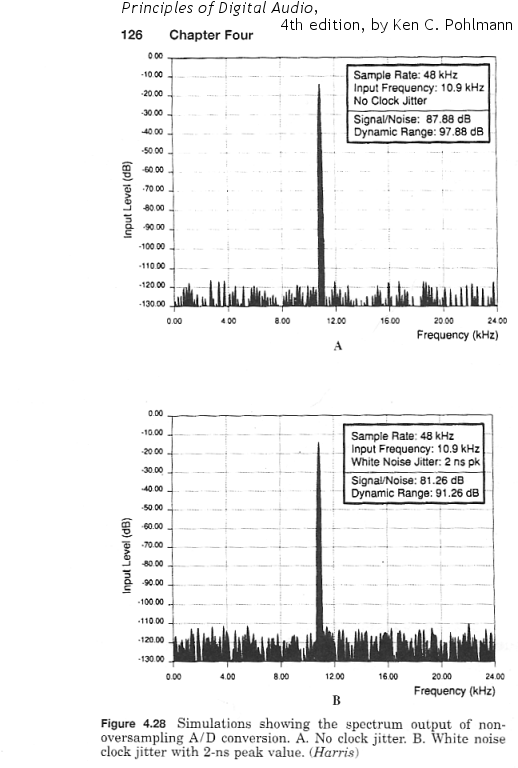Not the AES, but these guys did a bunch of tests and you can download the PDF for free:
I have read that paper as it is routinely posted on forums as proof that jitter is inaudible. As much as I admire anyone trying to characterize distortions like this, their approach is exceedingly faulty and the reason I made the comment that I did.
From their conclusion: The results indicate that the threshold for random jitter on program materials is several hundreds ns for well-trained listeners under their preferable listening conditions. The threshold values seem to be sufficiently larger than the jitter actually observed in various consumer products.
I am not going rehash all that they have done wrong as I have written about it many times. But just a few quick points for now:
1. "Random" jitter or for that matter, any other other random distortion turns out to be far more benign than program correlated jitter. If your projector has a fan, I bet you don't hear it most of the time. But imagine if the fan came on every time the screen became bright. I bet you will hear it much more often then. The brain tends to filter non-variant things as a way for you to focus on what is important.
Jitter induced in Audio equipment usually is not random. It could be induced by the power supply ripple voltage, it could be the oscillator for the FL display, it could be the video circuit bleeding into it, etc. Or it could track the source signal in certain ways. All of this generates much more objectionable distortion.
2. They let people play the content through their PCs. Did they profile those PCs first to see what level of jitter they had in them to start? No.
3. You have to pick material that is revealing of the distortion you are trying to find. I can take classical music, encode it at 64kbps and have 99% of the people say it is the same as music. I can then encode some guitar music and have everyone be able to tell the difference no mater how deaf. It almost seems like people assume there is no difference so they don't pay attention to things like this. As I have said before, lack of difference found is more of a fault of the technique than people's perception if the science says there is a difference (and the science definitely does as confirmed in the very article).
On this front, jitter destroys low order bits and can be especially audible where the ear is most sensitive. Knowing this and the fact that the higher the frequency, the more the problem, would lead you to special set of content you would want to use, rather than whatever happens to be on a CD on your desk.
4. As I have noted before, there will never be any proof that jitter is inaudible for the simple reason that jitter has infinite characteristics. It can be caused by one or more modulating signals each of which can have arbitrary frequency, magnitude and waveforms. So no study, no matter how comprehensive, can ever provide sufficient data that jitter cannot be heard in other circumstances.
The key is the last part, that even inexpensive consumer gear has jitter low enough to not matter.
A conclusion which is not supported in any way by their research since they did not show that consumer gear has random jitter. Or even what jitter they have regardless of type.
This makes sense, since jitter can also be expressed as artifacts some number of dB below the music. The graph below from Ken Pohlmann's book Principles of Digital Audio shows a typical level. If artifacts are 100 dB or more below the music, it's a stretch IMO to think that could ever be audible while the music plays.
Is the "music" always at 0db? It has to be for your statement to be true.
What I don't understand is why people seem to conclude that whatever shortcomings they may hear in their gear, it's due to jitter. Why jitter? Doesn't it make sense that room acoustic problems - which are at least four or five orders of magnitude larger! - is a far more likely culprit for lack of detail, smearing, and imaging etc?
--Ethan
In my case it is easy as i use electorstatic headphones to evaluate DACs so I am not impacted by the room.
That aside, it is common fallacy to assume that room distortion masks other types of distortion. Room distortion unless the walls are rattling, is linear in nature. Distortion such as jitter is not. Here is an example that may be easier to understand. If i take a 10 watt amp and drive it at its max volume with 20% THD, would I not hear the distortion due to room acoustics? Of course I would. The non-linearities would be quite obvious despite anything the room might do to the sound.
To be fair, it is true that people talk about jitter all the time as if they really understand it when in reality, it is a complex topic few of us have a good grasp of it, even though we are in the industry

.
Keep in mind that we can show mathematically what must be true for a digital system to reproduce its source. If we wan to regard digital perfect in this ability, we can't in the next breath dismiss the math and say that 8 bits of effective resolution at 20Khz is good enough all of a sudden because subjectively and anecdotally, we think that is OK. One has to either believe in the science or not

.







